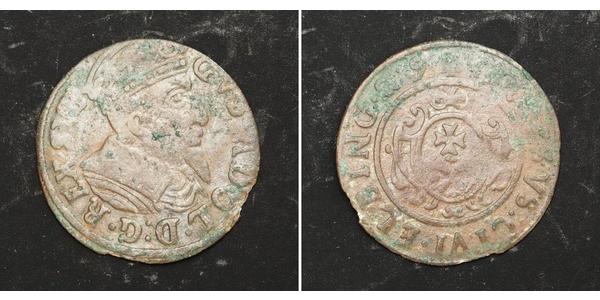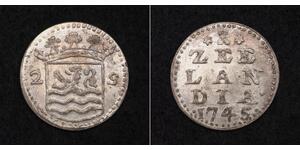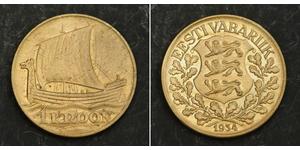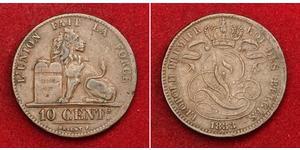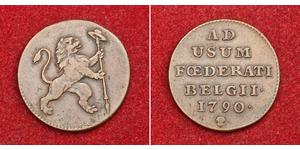(Vendida por $9.0)
Mint Year: 1629 Denomination: Grosz (Groschen) Mint Place: Elbing (Polish/German City State) Reference: Dutkowski/Suchanek 547, Ahlström 29b, KM-24 ($60 in VF!) Condition: Dark oxidation patina, greenish deposits (greenspan), lightly chipped edge, otherwise about VF! Diameter: 20mm Weight: 0.84gm Material: Silver
Obverse: Crowned, armored and draped bust of Gustav II Adolf of Sweden right. Legend: GVS . ADOL . D : G . REX . SVE
Reverse: Oval arms of Elbing within foliage. All within inner circle. Legend: * GROSSVS . CIVI : ELBING . 29
Elbląg(German: Elbing) is a city in northern Poland on the eastern edge of the Żuławy region with 124,257 inhabitants (December 31, 2011). It is the capital of Elbląg County and has been assigned (since 1999) to the Warmian-Masurian Voivodeship. Previously it was the capital of Elbląg Voivodeship (1975–1998) and a county seat within Gdańsk Voivodeship (1945–1975).
Gustav II Adolf (9 December 1594 – 6 November 1632, O.S.), widely known in English by his Latinised name Gustavus Adolphus or as Gustav II Adolph, was the King of Sweden from 1611 to 1632 and is credited as the founder of Sweden as a Great Power (Swedish: Stormaktstiden). He led Sweden to military supremacy during the Thirty Years' War, helping to determine the political as well as the religious balance of power in Europe. He was formally and posthumously given the name Gustavus Adolphus the Great (Swedish: Gustav Adolf den store, Latin: Gustavus Adolphus Magnus) by the Riksdag of the Estates in 1634.
He is often regarded as one of the greatest military commanders of all time, with innovative use of combined arms. His most notable military victory was the Battle of Breitenfeld (1631). With a superb military machine, good weapons, excellent training, and effective field artillery, backed by an efficient government that could provide necessary funds, Gustavus Adolphus was poised to make himself a major European leader. He was killed a year later, however, at the Battle of Lützen (1632). He was ably assisted in his efforts by Count Axel Oxenstierna, the Lord High Chancellor of Sweden, who also acted as regent after his death.
In an era characterized by almost endless warfare, Gustavus Adolphus king from 1611 (at age 16) until his death, inherited three simultaneous and ongoing wars of his father's (Charles IX). Two of these were border wars with Russia and Denmark, and a more personal war (for his father, at least) with Gustavus first cousin, king Sigismund of Poland. Of these three wars, the Danish war was the most acute one, as of 1611.
During his reign, Sweden rose from the status of a Baltic Sea power to one of the great powers of Europe and a model of early modern era government.[citation needed] Some have called him the "father of modern warfare", or the first great modern general. Under his tutelage, Sweden and the Protestant cause developed a number of excellent commanders, such as Lennart Torstensson, who would go on to defeat Sweden's enemies and expand the boundaries and the power of the empire long after Gustavus Adolphus' death in battle. Spoils of Adolphus' enemies meant he became a successful bookraider in Europe, specifically with Jesuit Collections.
Called "The Golden King" and "The Lion of the North", he made Sweden one of the great powers of Europe, in part by reforming the administrative structure. For example, he began parish registration of the population, so that the central government could more efficiently tax and conscript the people. Historian Christer Jorgensen argues that his achievement in the field of economic reform, trade, modernization, and the creation of the modern bureaucratic autocracy was as great as his exploits on the battlefields. His domestic reforms, which transformed a backward, almost medieval economy and society, were in fact not only the foundations for his victories in Germany, but also absolutely crucial for the creation and survival of the Swedish Empire.
Only 1$ shipping for each additional coin purchased!

1 Shilling Sacro Imperio Romano (962-180 ...
grupo tiene 4 monedas / 4 precios
Add coin to this group

10 Reis Reino de Portugal (1139-1910) Co ...
grupo tiene 5 monedas / 5 precios
Add coin to this group
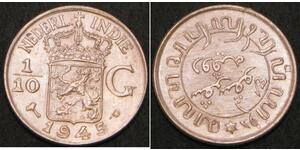
1/10 Gulden Indias Orientales Neerlandes ...
grupo tiene 10 monedas / 9 precios
Add coin to this group
10 Centime Bélgica Cobre Leopoldo I de Bélgica (1790-1865)
grupo tiene 8 monedas / 8 precios
⇑
1 Liard Bélgica Cobre
grupo tiene 4 monedas / 4 precios
⇑

